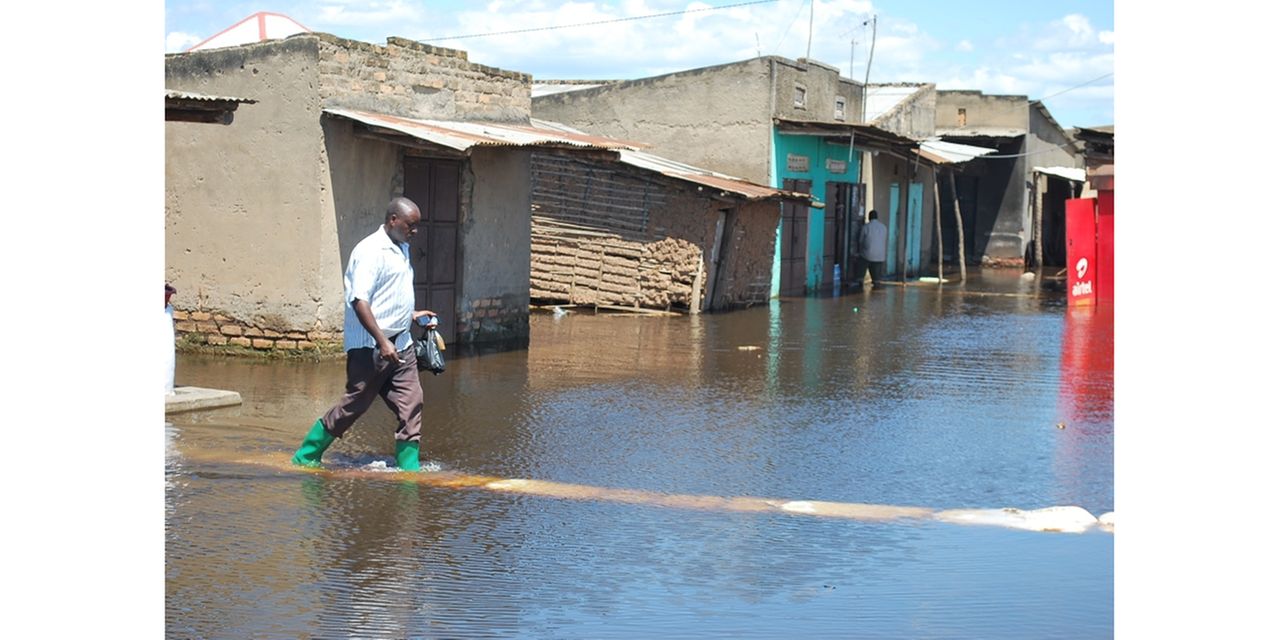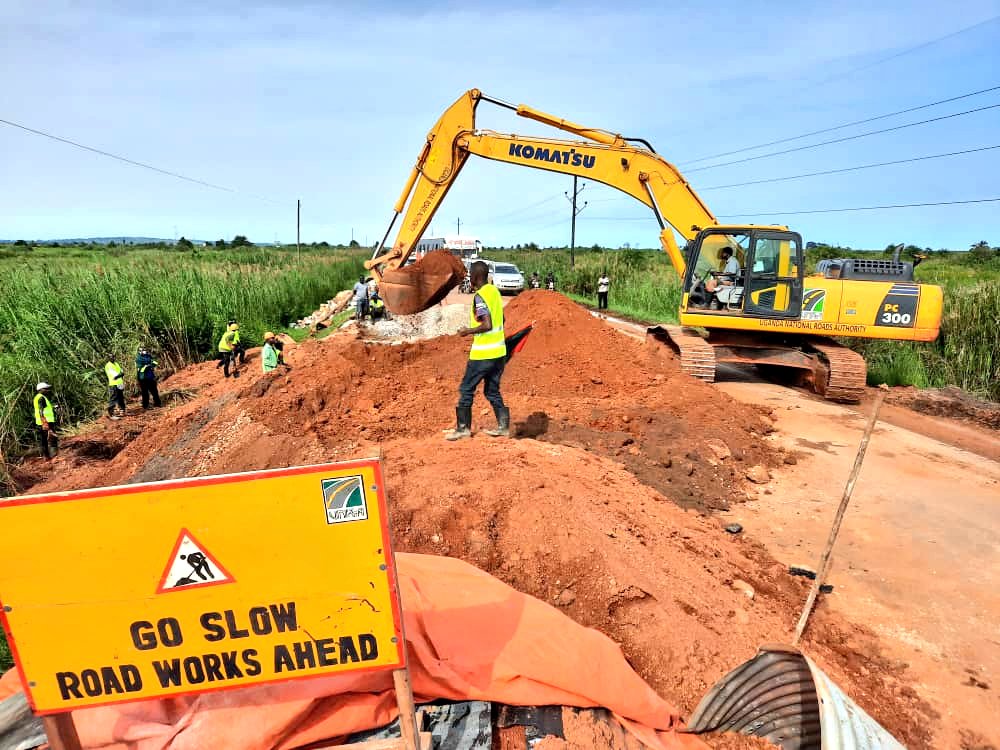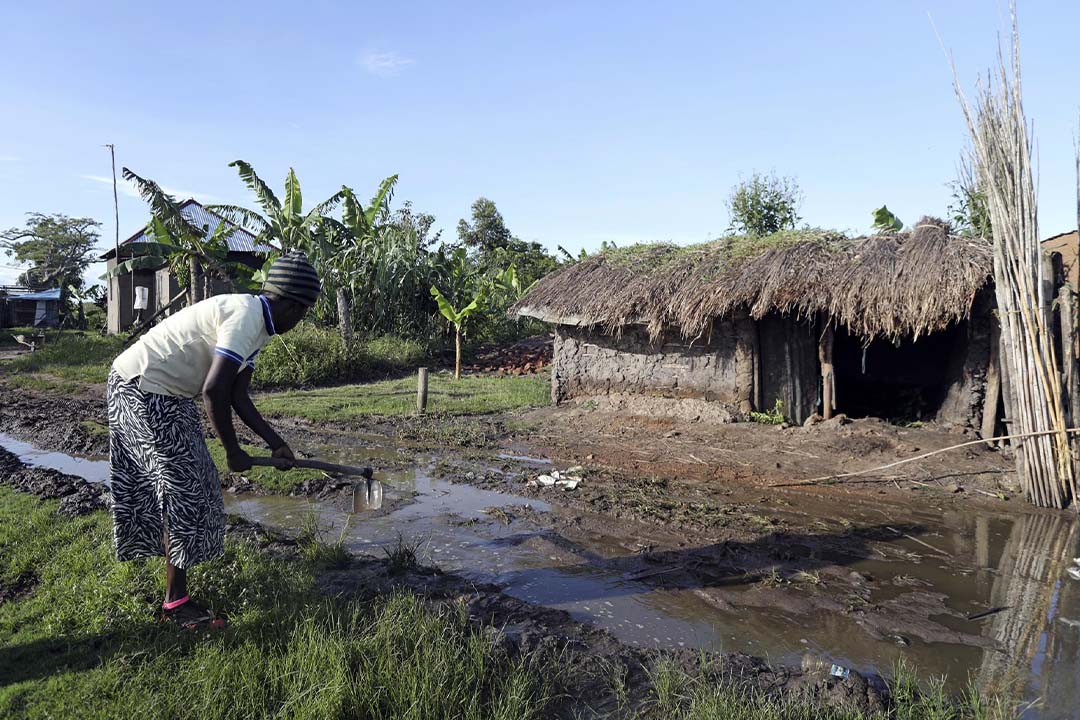Almost annually, motorists are advised to use alternative routes, often three times the distance, to avoid delays that last longer than eight hours. In 2021, residents of Kamuwunga Village in Lukaya Town Council protested the frequent flooding in their homes and neighbourhoods.
The Local Council One Chairperson, Ronald Ssemanda, identified sand mining in the region as the main contributing factor to the floods. He explained that rather than the water retreating into the Lake as before, it now stagnates in their homes, thus increasing the vulnerability to contracting water-borne diseases such as cholera and dysentery.

He rallied his community members to protest the ongoing sand mining operations, calling for the government to intervene and stop the “illegal activities.”
When we visited Ssemanda in February 2023, his fortunes had not improved much. The rains were pounding the ground hard, and over half of the village was flooded. Residents slept in flooded houses, and their crops - primarily sweet potatoes and yams were submerged.
“Several community members have left the area to rent elsewhere or moved deeper into the villages to find places to grow food. Some have encroached on the nearby forest and swamp because their cries for help from the government fell on deaf ears,” he said.
In January 2023, Daily Monitor, a local newspaper, reported that over 5,000 people had fled the area due to flooding. With the rains persistent, the situation has only gotten worse.
Background
In September 2016, the Government of Uganda licenced three companies – with two owned by Chinese investors to mine sand in the wetland that drains directly into Lake Victoria. These companies are He Sha Duo Company Limited, Lukaya Sand Dealers and Seroma Limited, a local company.
However, when the Parliamentary Committee on Natural Resources visited the sand mining sites in 2021, they discovered eight other unlicenced companies claiming to be subsidiaries of the three, also mining sand - mostly in illegal and non-compliant ways.

The Kalungu District Local Government, under whose auspices the 22 kilometres swamp sits, quickly swung into action to audit, arrest or licence the mining companies. The district local government hastily licenced another Chinese-owned company, Double Q Co. Limited.
The conflict between the sand miners and the several Lake Victoria-area districts has lasted a while. In Wakiso District, the Chairperson of Local Council Five, Matia Lwanga Bwanika, told a local television station that the state protected the sand miners of Chinese descent.
Among the findings from the Parliamentary Committee on Natural Resources was that all four companies were culpable for, among other illegalities, leaving sand borrow bits unrestored, transporting wet sand contrary to the issued permits, mining sand within 200 metres of the Kampala-Masaka highway, thus weakening the road and encroaching on the road buffer zone.
When the proprietors of Lukaya Sand Dealers, Sun Xia Nzhong and Shi Jian Feng, were reached for comment on the resident’s concerns and a follow-up of the Parliament Committee’s findings, the duo said they could not speak to the media and instead directed us to the company’s Business Development Manager, Chris Irumba who said they had effected all the recommendations. However, we could not independently verify his claims.
By press time, this reporter had not heard back from the management of He Sha Dou. According to the on-site employees, both directors, He Wei Chai and He Han Xiu, were “out of the country”.
The effects and their consequences
Barely a year after the sand mining operations started in the Lwera swamp, the effects could be felt immediately. The National Environment Management Authority (NEMA), Uganda’s environmental regulator, was the first to raise a red flag in 2018.
“A traditional fishing village, Kamaliba, which three mining companies surround, has been ravaged by the activities of these miners. The village has lost shelter, toilets, access roads, recreation land and land for cultivation as some developers have expanded their mines beyond the permitted boundaries,” NEMA wrote in this press release.
The Authority also hinted at the cost of sand mining on road destruction. It recommended that the government factors this “hidden cost” into their taxation mechanisms for the trade, adding that sand should be listed among other minerals of commercial value so that access to it is controlled and the revenues accruing from its exploitation managed as is the case with other minerals.
The cost, however, goes beyond the road, fish and human displacement. The disruption of the ecosystem by mining activities has also threatened the biodiversity in the wetland and given birth to new problems for Lake Victoria, the world’s second-largest freshwater body.
The Lwera swamp is the primary breeding ground for grasshoppers, a major delicacy in Uganda and an important source of livelihood for the population in the greater Masaka area. However, due to the loss of biodiversity in the Lwera swamp, the grasshopper population has since been reduced. Residents who relied on the delicious insects as their major source of income have been counting losses recently.
Twaha Kavuma, 34, a resident of Nyendo in Masaka Municipality, previously employed at least 14 young people in his grasshopper operations during the peak months of November, February and May.
In a prosperous year, he generated a profit of at least Ushs 17m (US$4,700). In 2022, Twaha could not even squeeze out Ushs3m (US$850) and expects the profits to dive even deeper in 2023.
For Harriet Nyanyanzi, 49, a mother of three whose food and livelihood came from farming in this swamp, life has not been the same since 2018 when she noticed her mud house walls absorbing water, which has since grown into floods.
“I used to grow sweet potatoes near the swamp to feed my family and harvest enough to sell, but now, water kills the plants whenever I plant. We have moved house three times since 2018 because of water. At times, we would spend the whole night pouring water out of the house using buckets,” she said.
Local traders at the famous Lukaya Market along the Kampala – Masaka highway also bemoan the sand mining activities, which they claimed has increased malaria prevalence in their area due to the increase in mosquito reproduction in the stagnant water ponds left after sand mining.
Matters worsened in May 2023 when the Katonga River bridge was washed away by floods not so far from where the contested sand mining activities are ongoing, reigniting the debate on their environmental impact.
With traffic diverted for more than six months, traders in Lukaya Market lost trillions of shillings, further exacerbating their already volatile economic situation.
“We have not benefited anything from the sand mining. We have lost everything from the fish to our health and livelihood. What you see from the road is just the surface, but when you go further into the swamp, you will get the full picture,” said one of the traders, who only identified himself as Augustine.
Restoring biodiversity: the bamboo solution
In 2022, the Chinese Embassy in Uganda, in partnership with the Uganda Bamboo Association, started planting 15 million bamboo trees in the Lwera swamp and the Nakasongola District to replenish the lost biodiversity in areas where its citizens conduct operations with significant environmental effects.
Under the Economics and Commercial Affairs office, the Embassy is undertaking one of Uganda’s most ambitious bamboo planting yet, with a target of 15 million trees over the next two years.
Drake Ndyamuhaki, the founder of the Bamboo Concept Centre, one of the implementing companies for the bamboo planting project, told the Last Drop Africa Podcast that the Embassy and Uganda Bamboo Association has also trained over 15,000 young people on various aspects of the bamboo value chain to create employment opportunities and household income.
“About 15 Uganda entrepreneurs, including myself, were taken to China and trained for two months on how to handle this precious plant. We are currently propagating a hybrid species seedling distributed to select locations for planting and commercial production. The plant cannot only hold the soil and curb landslides but can also be used as raw material to manufacture household products that can replace plastics.”
According to Chris Irumba, the Business Development Manager at Lukaya Sand Dealers, a Chinese-owned licenced sand mining company in the Lwera wetland, over two million bamboo seedlings are earmarked for planting.
“We should have finished the task by now, but the rainy weather conditions have made it difficult to proceed,” Irumba said, adding that at least half a million bamboo trees have been planted where sand mining has been completed.
Besides their wood benefits, bamboo is a major carbon sink. It acts as a windbreak, using its extensive root systems to control soil erosion and prevent flooding and landslides. The plant is one of the fastest growing in the world, with additional ecological benefits such as retaining moisture and raising water tables, thereby reversing desertification.
In 2019, Uganda rolled out a 10-year National Bamboo Strategy and Action Plan. The strategy focuses on managing the country’s bamboo resources to provide economic, social, and environmental benefits.
According to the strategy, planting and managing bamboo will contribute an estimated 15% towards Uganda’s goal of restoring 2.5 million hectares of forest landscape by 2030, of which about 28% will be on government land and the remaining on private land.
The Ministry of Water and Environment estimates that the strategy will help create 150,000 full-time jobs, producing 140 million bamboo poles annually.
This article was produced as a result of a grant provided by the Africa-China Reporting Project at the Wits Centre for Journalism at the University of the Witwatersrand, Johannesburg. The opinions held are of the author(s).

